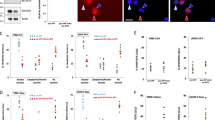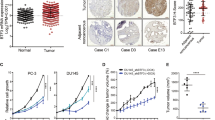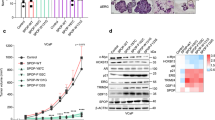Abstract
Survivin is a prosurvival protein overexpressed in many cancers through mechanisms that remain poorly explored, and is implicated in control of tumor progression and resistance to cancer chemotherapeutics. Here, we report a critical role for survivin in the induction of apoptosis by transforming growth factor-β (TGF-β). We show that TGF-β rapidly downregulates survivin expression in prostate epithelial cells, through a unique mechanism of transcriptional suppression involving Smads 2 and 3, Rb/E2F4, and the cell-cycle repressor elements CDE and CHR. This TGF-β response is triggered through a Smad2/3-dependent hypophosphorylation of Rb and the subsequent association of the Rb/E2F4 repressive complex to CDE/CHR elements in the proximal region of the survivin promoter. Viral-mediated gene delivery experiments, involving overexpressing or silencing survivin, reveal critical roles of survivin in apoptosis induced by TGF-β alone or in cooperation with cancer therapeutic agents. We propose a novel TGF-β/Rb/survivin axis with a putative role in the functional switch of TGF-β from tumor suppressor to tumor promoter.
This is a preview of subscription content, access via your institution
Access options
Subscribe to this journal
Receive 50 print issues and online access
$259.00 per year
only $5.18 per issue
Buy this article
- Purchase on Springer Link
- Instant access to full article PDF
Prices may be subject to local taxes which are calculated during checkout







Similar content being viewed by others
Abbreviations
- 3TP-Lux:
-
3TP-luciferase
- CA-ALK5:
-
constitutively active ALK5
- Cdk:
-
cyclin-dependent kinase
- DC-FBS:
-
dextran charcoal-treated FBS
- DMEM/F-12:
-
Dulbecco's modified Eagle's medium/Ham's F-12
- DNAP:
-
DNA pull-down assay
- EMSA:
-
electrophoretic mobility shift assay
- FACS:
-
fluorescence-activated cell sorting
- FBS:
-
fetal bovine serum
- HEK293T:
-
human embryonic kidney cell line 293 inserted with SV40 T antigen
- IAP:
-
inhibitor of apoptosis
- P-Rb:
-
phosphorylated Rb
- P-Smad:
-
phosphorylated Smad
- Rb:
-
retinoblastoma protein
- R-Smad:
-
receptor-regulated Smad
- SAC:
-
a 32-bp survivin promoter region (−50/−19) containing SBE2, CDE and CHR elements
- SBE:
-
Smad-binding element
- shRNA:
-
short-hairpin RNA
- TβRI:
-
TGF-β receptor type I
- TβRII:
-
TGF-β receptor type II
- TGF-β:
-
transforming growth factor-β
References
Altieri DC . (2003a). Survivin, versatile modulation of cell division and apoptosis in cancer. Oncogene 22: 8581–8589.
Altieri DC . (2003b). Validating survivin as a cancer therapeutic target. Nat Rev Cancer 3: 46–54.
Bello D, Webber MM, Kleinman HK, Wartinger DD, Rhim JS . (1997). Androgen responsive adult human prostatic epithelial cell lines immortalized by human papillomavirus 18. Carcinogenesis 18: 1215–1223.
Chen CR, Kang Y, Siegel PM, Massague J . (2002). E2F4/5 and p107 as Smad cofactors linking the TGFbeta receptor to c-myc repression. Cell 110: 19–32.
Chipuk JE, Bhat M, Hsing AY, Ma J, Danielpour D . (2001). Bcl-xL blocks transforming growth factor-beta 1-induced apoptosis by inhibiting cytochrome c release and not by directly antagonizing Apaf-1-dependent caspase activation in prostate epithelial cells. J Biol Chem 276: 26614–26621.
Chipuk JE, Cornelius SC, Pultz NJ, Jorgensen JS, Bonham MJ, Kim SJ et al. (2002). The androgen receptor represses transforming growth factor-beta signaling through interaction with Smad3. J Biol Chem 277: 1240–1248.
Danielpour D . (2005). Functions and regulation of transforming growth factor-beta (TGF-beta) in the prostate. Eur J Cancer 41: 846–857.
Danielpour D, Kadomatsu K, Anzano MA, Smith JM, Sporn MB . (1994). Development and characterization of nontumorigenic and tumorigenic epithelial cell lines from rat dorsal-lateral prostate. Cancer Res 54: 3413–3421.
Danielpour D, Song K . (2006). Cross-talk between IGF-I and TGF-beta signaling pathways. Cytokine Growth Factor Rev 17: 59–74.
Derynck R, Zhang YE . (2003). Smad-dependent and Smad-independent pathways in TGF-beta family signalling. Nature 425: 577–584.
Frederick JP, Liberati NT, Waddell DS, Shi Y, Wang XF . (2004). Transforming growth factor beta-mediated transcriptional repression of c-myc is dependent on direct binding of Smad3 to a novel repressive Smad binding element. Mol Cell Biol 24: 2546–2559.
Harbour JW, Dean DC . (2000). Rb function in cell-cycle regulation and apoptosis. Nat Cell Biol 2: E65–E67.
Heinemeyer T, Wingender E, Reuter I, Hermjakob H, Kel AE, Kel OV et al. (1998). Databases on transcriptional regulation: TRANSFAC, TRRD and COMPEL. Nucleic Acids Res 26: 362–367.
Hilger-Eversheim K, Moser M, Schorle H, Buettner R . (2000). Regulatory roles of AP-2 transcription factors in vertebrate development, apoptosis and cell-cycle control. Gene 260: 1–12.
Hsing AY, Kadomatsu K, Bonham MJ, Danielpour D . (1996). Regulation of apoptosis induced by transforming growth factor-beta1 in nontumorigenic rat prostatic epithelial cell lines. Cancer Res 56: 5146–5149.
Inman GJ, Nicolas FJ, Callahan JF, Harling JD, Gaster LM, Reith AD et al. (2002). SB-431542 is a potent and specific inhibitor of transforming growth factor-beta superfamily type I activin receptor-like kinase (ALK) receptors ALK4, ALK5, and ALK7. Mol Pharmacol 62: 65–74.
Jackson MW, Agarwal MK, Yang J, Bruss P, Uchiumi T, Agarwal ML et al. (2005). p130/p107/p105Rb-dependent transcriptional repression during DNA-damage-induced cell-cycle exit at G2 . J Cell Sci 118: 1821–1832.
Jarrard DF, Modder J, Fadden P, Fu V, Sebree L, Heisey D et al. (2002). Alterations in the p16/pRb cell cycle checkpoint occur commonly in primary and metastatic human prostate cancer. Cancer Lett 185: 191–199.
Jiang Y, Saavedra HI, Holloway MP, Leone G, Altura RA . (2004). Aberrant regulation of survivin by the RB/E2F family of proteins. J Biol Chem 279: 40511–40520.
Kishi H, Igawa M, Kikuno N, Yoshino T, Urakami S, Shiina H . (2004). Expression of the survivin gene in prostate cancer: correlation with clinicopathological characteristics, proliferative activity and apoptosis. J Urol 171: 1855–1860.
Knudsen KE, Weber E, Arden KC, Cavenee WK, Feramisco JR, Knudsen ES . (1999). The retinoblastoma tumor suppressor inhibits cellular proliferation through two distinct mechanisms: inhibition of cell cycle progression and induction of cell death. Oncogene 18: 5239–5245.
Le Cam L, Polanowska J, Fabbrizio E, Olivier M, Philips A, Ng Eaton E et al. (1999). Timing of cyclin E gene expression depends on the regulated association of a bipartite repressor element with a novel E2F complex. EMBO J 18: 1878–1890.
Liston P, Fong WG, Korneluk RG . (2003). The inhibitors of apoptosis: there is more to life than Bcl2. Oncogene 22: 8568–8580.
Liu N, Lucibello FC, Korner K, Wolfraim LA, Zwicker J, Muller R . (1997). CDF-1, a novel E2F-unrelated factor, interacts with cell cycle-regulated repressor elements in multiple promoters. Nucleic Acids Res 25: 4915–4920.
Lucibello FC, Liu N, Zwicker J, Gross C, Muller R . (1997). The differential binding of E2F and CDF repressor complexes contributes to the timing of cell cycle-regulated transcription. Nucleic Acids Res 25: 4921–4925.
Massague J, Seoane J, Wotton D . (2005). Smad transcription factors. Genes Dev 19: 2783–2810.
Massague J, Wotton D . (2000). Transcriptional control by the TGF-beta/Smad signaling system. EMBO J 19: 1745–1754.
Pennati M, Binda M, Colella G, Zoppe M, Folini M, Vignati S et al. (2004). Ribozyme-mediated inhibition of survivin expression increases spontaneous and drug-induced apoptosis and decreases the tumorigenic potential of human prostate cancer cells. Oncogene 23: 386–394.
Roberts AB, Wakefield LM . (2003). The two faces of transforming growth factor beta in carcinogenesis. Proc Natl Acad Sci USA 100: 8621–8623.
Salvesen GS, Duckett CS . (2002). IAP proteins: blocking the road to death's door. Nat Rev Mol Cell Biol 3: 401–410.
Shariat SF, Lotan Y, Saboorian H, Khoddami SM, Roehrborn CG, Slawin KM et al. (2004). Survivin expression is associated with features of biologically aggressive prostate carcinoma. Cancer 100: 751–757.
Sharma A, Comstock CE, Knudsen ES, Cao KH, Hess-Wilson JK, Morey LM et al. (2007). Retinoblastoma tumor suppressor status is a critical determinant of therapeutic response in prostate cancer cells. Cancer Res 67: 6192–6203.
Shi Y, Massague J . (2003). Mechanisms of TGF-beta signaling from cell membrane to the nucleus. Cell 113: 685–700.
Song K, Cornelius SC, Danielpour D . (2003a). Development and characterization of DP-153, a nontumorigenic prostatic cell line that undergoes malignant transformation by expression of dominant-negative transforming growth factor beta receptor type II. Cancer Res 63: 4358–4367.
Song K, Cornelius SC, Reiss M, Danielpour D . (2003b). Insulin-like growth factor-I inhibits transcriptional responses of transforming growth factor-beta by phosphatidylinositol 3-kinase/Akt-dependent suppression of the activation of Smad3 but not Smad2. J Biol Chem 278: 38342–38351.
Song K, Wang H, Krebs TL, Danielpour D . (2006). Novel roles of Akt and mTOR in suppressing TGF-beta/ALK5-mediated Smad3 activation. EMBO J 25: 58–69.
Tang B, De Castro K, Barnes HE, Parks WT, Stewart L, Bottinger EP et al. (1999). Loss of responsiveness to transforming growth factor beta induces malignant transformation of nontumorigenic rat prostate epithelial cells. Cancer Res 59: 4834–4842.
Taylor WR, Schonthal AH, Galante J, Stark GR . (2001). p130/E2F4 binds to and represses the cdc2 promoter in response to p53. J Biol Chem 276: 1998–2006.
Ten Dijke P, Hill CS . (2004). New insights into TGF-beta-Smad signalling. Trends Biochem Sci 29: 265–273.
Wajapeyee N, Britto R, Ravishankar HM, Somasundaram K . (2006). Apoptosis induction by activator protein 2alpha involves transcriptional repression of Bcl-2. J Biol Chem 281: 16207–16219.
Wang H, Song K, Sponseller TL, Danielpour D . (2005). Novel function of androgen receptor-associated protein 55/Hic-5 as a negative regulator of Smad3 signaling. J Biol Chem 280: 5154–5162.
Wrana JL, Attisano L, Carcamo J, Zentella A, Doody J, Laiho M et al. (1992). TGF beta signals through a heteromeric protein kinase receptor complex. Cell 71: 1003–1014.
Zawel L, Dai JL, Buckhaults P, Zhou S, Kinzler KW, Vogelstein B et al. (1998). Human Smad3 and Smad4 are sequence-specific transcription activators. Mol Cell 1: 611–617.
Zhang M, Latham DE, Delaney MA, Chakravarti A . (2005). Survivin mediates resistance to antiandrogen therapy in prostate cancer. Oncogene 24: 2474–2482.
Acknowledgements
This research was supported by the Gene Expression and Genotyping Facility, the Flow Cytometry Core Facility of the Case Comprehensive Cancer Center (P30 CA43703). Grant support: NCI grants R01CA092102 and R01CA102074 (to D Danielpour).
Author information
Authors and Affiliations
Corresponding author
Additional information
Supplementary Information accompanies the paper on the Oncogene website (http://www.nature.com/onc)
Supplementary information
Rights and permissions
About this article
Cite this article
Yang, J., Song, K., Krebs, T. et al. Rb/E2F4 and Smad2/3 link survivin to TGF-β-induced apoptosis and tumor progression. Oncogene 27, 5326–5338 (2008). https://doi.org/10.1038/onc.2008.165
Received:
Revised:
Accepted:
Published:
Issue Date:
DOI: https://doi.org/10.1038/onc.2008.165
Keywords
This article is cited by
-
Early Cellular Responses of Prostate Carcinoma Cells to Sepantronium Bromide (YM155) Involve Suppression of mTORC1 by AMPK
Scientific Reports (2019)
-
Overexpression of apoptosis-related protein, survivin, in fibroblasts from patients with systemic sclerosis
Irish Journal of Medical Science (1971 -) (2019)
-
Epigenetic mechanism of survivin dysregulation in human cancer
Science China Life Sciences (2018)
-
Breast Cancer Stem Cells, Pathways and Therapeutic Perspectives 2011
Indian Journal of Surgery (2013)
-
Synergistic antitumor activity of lapatinib and retinoids on a novel subtype of breast cancer with coamplification of ERBB2 and RARA
Oncogene (2012)



